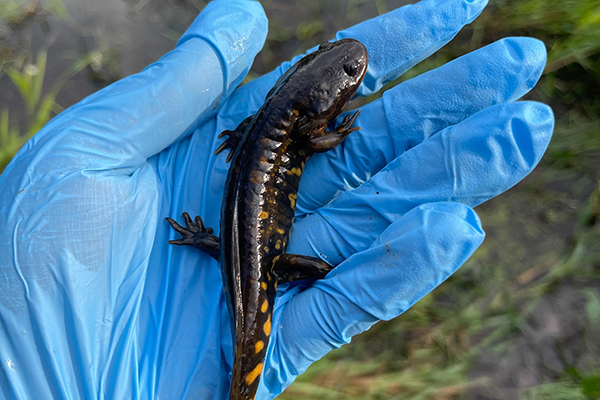
This project will support the development of a statewide chytrid fungi response plan by generating a risk model, increasing surveillance efforts, and creating open-access educational materials.
Background:
Amphibians play a critical role in maintaining ecosystem health. The global spread of the chytrid fungus Batrachochytrium dendrobatidis (Bd) has been associated with declines in amphibian populations and local extinctions, marking the greatest recorded loss of biodiversity due to a disease. However, an emerging chytrid fungus, Batrachochytrium salamandrivorans (Bsal), has been responsible for high levels of mortality in salamander populations in Europe, and its introduction into the United States could pose significant threats to amphibian biodiversity. In the proposed project, the researchers aim to generate a risk model of Bsal across Minnesota and, in turn, inform management opportunities. The outputs of this study will be used to guide surveillance activities and targeted science communication efforts, forming the basis for a statewide response plan.
Activities:
- Generate risk models for Chytrid fungus across Minnesota
- Develop and implement surveillance networks for pathogens in amphibian populations
- Cultivate a substantial knowledge base regarding chytrid fungi and their potential impacts on the state
Join our Minnesota SNAPS network!
Student Network for Amphibian Pathogen Surveillance (SNAPS) is an experiential learning network that mobilizes students and educators to detect emerging pathogens in amphibians. SNAPS provides supplies, like swabs, for sampling amphibians for pathogens. They also provide optional lesson plans which educators can incorporate into a variety of courses. Educators send their swab samples to the National Wildlife Health Center. There, our collaborators analyze the samples to test for organisms like Bsal and Bd. The Center shares those test results with educators and students. SNAPS test results are also publicized via the Amphibian Disease Portal. Learn more about SNAPS.
Are you an educator associated with a college or university in Minnesota? Or a leader or volunteer for a wildlife or conservation related organization in the state? Do you want to engage students and members in hands-on research experiences? If so, consider joining the Minnesota SNAPS network! You can fill out this Google Form to share your contact information with us.
Please note that although recruitment into the National SNAPS program may be closed, our initiative in Minnesota is actively recruiting thanks to funding from MAISRC.
Curious about what it might look like to incorporate SNAPS into a classroom setting? Check out the poster that Dr. Jen Lamb (SCSU) presented at the 2024 Minnesota Wildlife Society conference.
Have questions? Please reach out to our Project Manager Dr. Amy Kinsley.
 |  |
